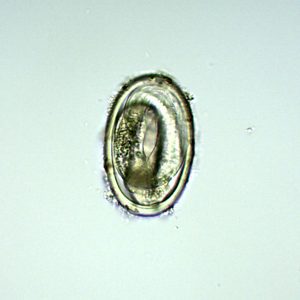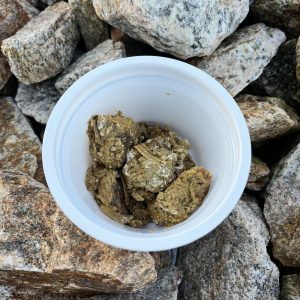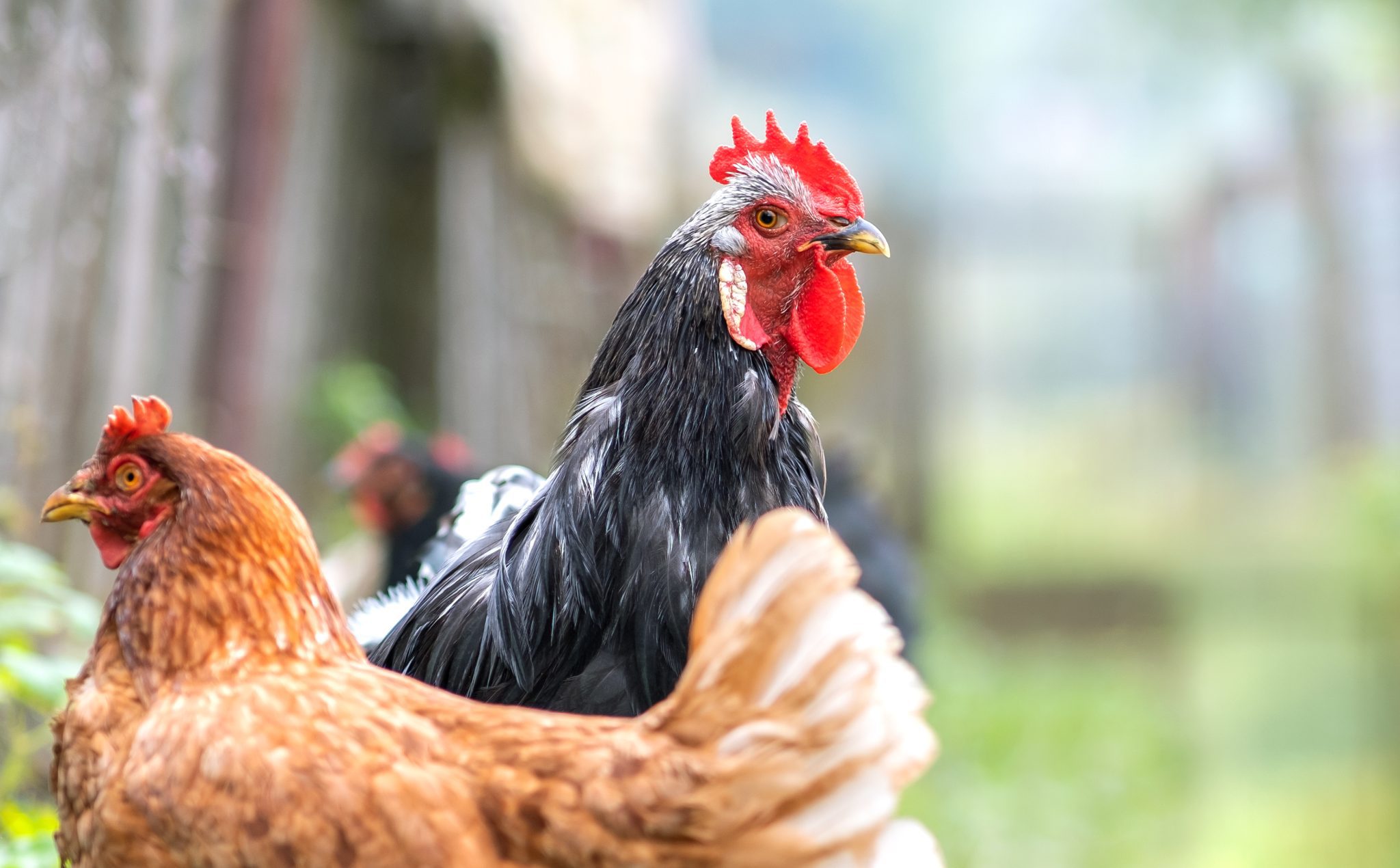Farming

The fecal flotation test is an important parasitological examination tool used in the poultry industry. Accurate diagnosis requires that certain steps be followed when collecting and submitting feces from your flock for testing.
Internal parasites are common in birds raised outdoors. However, control can be difficult because parasitic eggs or oocysts are resistant to environmental conditions. Your local veterinarian can conduct a simple parasitological exam to give you information about the endoparasites affecting your flock. A proper diagnosis is crucial so the right treatment and control program can be created for your flock.
Species of Parasites

Figure 1. Infective roundworm (Ascaridia galli) egg.
Control of internal parasites begins with understanding the species and life cycles of intestinal worms that affect poultry. Among these are Ascaridia galli (roundworm) (figure 1), Capilaria (threadworm), and Heterakis gallinarum (cecal worm).
These worm species are nematodes, meaning they have rounded bodies and a direct life cycle. Completion of their life cycles takes a long time. Adults are seen in the intestine starting 3 to 6 weeks after birds are infected and remain there for months. During this time, the worms shed eggs. The eggs are not infective right away; they need to develop (embryonate) in the environment for at least 2 weeks. Birds get infected when they ingest feces contaminated with embryonated eggs of these parasites. The eggs are highly resistant to environmental stress and can survive for years.
In addition to intestinal worms, coccidia (single-cell parasites) can live in the intestines of birds, causing coccidiosis. Symptoms such as diarrhea typically manifest a week or so after exposure; however, it may take several weeks before the symptoms become noticeable. Depending on the type of coccidia, coccidiosis might kill birds.
Like nematodes, coccidia have a direct life cycle, and it takes several days before their oocysts (eggs) are infective to other birds. Like worm eggs, oocysts are resistant to environmental stress. Some commercial feeds contain coccidiostats, such as amprolium, to help prevent coccidiosis. This makes coccidia control easier compared to worm control. Amprolium is not an antibiotic and functions only by disrupting the life cycle of the coccidia. Commercial feeds with coccidiostats are labeled as medicated at your local feed store.
Control Strategies
A method of worm control recommended by some is prophylactic deworming, which consists of creating a deworming schedule for your birds. However, this approach is not advised as it increases the chances of selecting drug-resistant worms. In addition, these drugs are used only in birds, leaving the environment still contaminated with worm eggs.
Another strategy is to monitor the shedding of parasite eggs with fecal exams. Testing requires a small feces sample to identify the problem-causing parasites: coccidia, cecal worms, roundworms, threadworms, or tapeworms. A threshold for starting treatment can be established to keep the flock under a lower infection pressure.
It is common to have subclinical cases in which no symptoms are observable. Your birds could have poor digestion of nutrients making them more susceptible to diseases. Consult your veterinarian for guidance.
Collecting Feces for Testing
If done correctly, a parasitological exam adds value to your backyard flock. But you need to start with a representative feces sample and provide specific information to your veterinarian.
1. History
Flock history is important for an internal parasitological exam and for every type of sample you submit for testing. It is essential to have a sheet containing the following information:
- Type(s) of bird: layer, broiler, turkey, duck, goose, partridge, quail, pheasant, etc.
- Age of birds
- Size and number of each flock, including number of each bird type if you have multiple bird types in your flock
- Reason(s) why you are sending the samples (can be just for monitoring parasites)
- If you are using any type of treatment or control measures
- Symptoms: changes in behavior, egg production, feed, and water intake
2. Amount and Representation

Figure 2. Poultry droppings collected for evaluation
3. Packaging
Place feces inside a plastic ziplock bag and make sure it does not leak. You can use two bags to reduce the likelihood of leaks.
4. Labeling
Identifying the sample is extremely important, especially if you send several samples. Include your name, the date of sample collection, and where it came from. If there is more than one sample, you can number them, but remember what the numbers represent. A paper record or photo can help you remember. Place the sheet of paper with the information inside another plastic bag to prevent it from getting wet or dirty.
5. Temperature and Transportation
Place the sample inside a Styrofoam box and deliver it to the vet. If mailing, add an ice pack to keep it cool and ship it either overnight or for 2-day delivery. If the sample gets too warm, bacteria can grow; if that happens, there is nothing the vet can do with it.
Summary
A fecal exam is a snapshot of your flock’s internal parasite status at a given time. Even if a fecal exam does not show eggs (oocysts), parasites can still become an issue in the future. You need to take samples over time to stay aware of your flock’s parasite situation. Biosecurity measures should be part of your daily routine to help prevent your flocks from catching internal parasites and other diseases.
No set schedule tells you when to treat your animals. That is a matter to be determined by you and your veterinarian based on the challenges your flock faces and testing results. Your veterinarian will be the best person to give you instructions on treating your flock.
Resources
Extension publications “Backyard Poultry Worm Control” (ANR-2851) and “Biosecurity for Backyard Poultry Flocks” (ANR-2391), both at www.aces.edu.
 Maria Tereza Bethonico Terraa, Graduate Research Assistant; Dianna Bourassa, Extension Specialist, Assistant Professor, Poultry Science; Rüdiger Hauck, Assistant Professor, Pathobiology; Ken Macklin, Extension Specialist, Professor, Poultry Science; and Wilmer Pacheco, Extension Specialist, Associate Professor, Poultry Science, all with Auburn University
Maria Tereza Bethonico Terraa, Graduate Research Assistant; Dianna Bourassa, Extension Specialist, Assistant Professor, Poultry Science; Rüdiger Hauck, Assistant Professor, Pathobiology; Ken Macklin, Extension Specialist, Professor, Poultry Science; and Wilmer Pacheco, Extension Specialist, Associate Professor, Poultry Science, all with Auburn University
New June 2022, How to Collect Chicken Droppings for a Parasite Exam, ANR-2895

